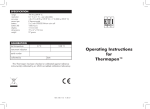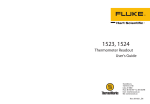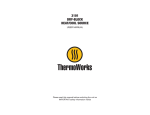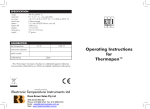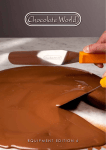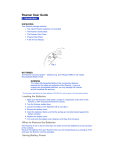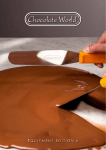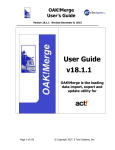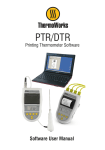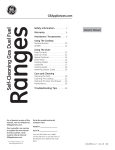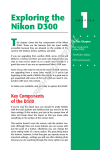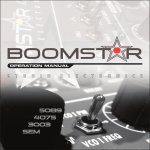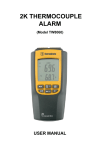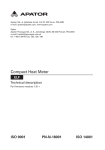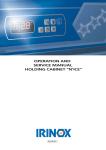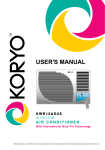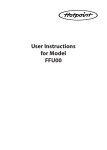Download THERMAPEN - ThermoWorks.com
Transcript
U sin g Your THERMAPE N TM A Guide to Better Food Through the Proper Use and Care of Your Splash-Proof Thermapen TM Quick Tips for Your ThermapenTM 1. Your ThermapenTM doesn’t test “doneness,” it tests temperature very accurately (see page 5). 2. Your ThermapenTM doesn’t lock in on a reading. It is accurate enough to show the ever-changing temperature of your food while it cooks (see page 5). 3. Your ThermapenTM measures temperatures at the tip of its probe (see page 7). Penetrate your food with the probe tip where you want to measure—usually the center of the thickest part of your food (see page 10). 4. Never leave your ThermapenTM in an oven while cooking (see page 18). 5. In general, be sure to thaw meats before cooking (see page 8). 6. Remember that the temperature of meat normally continues to rise a bit after you remove it from the oven or grill (see page 11). 7. Don’t test the accuracy of a thermometer in food. Use a properly made ice bath (see page 14). 8. Be sure to clean your ThermapenTM probe after every exposure to uncooked meat (see page 17). 9. Wipe your ThermapenTM regularly, but don’t place it under the tap, submerge it, or put it in the dishwasher (see page 17). 10.The battery compartment cover is tight for water-resistance. Be careful not to force it open (see page 20). Product Warranty The ThermapenTM includes a one-year limited warranty and guarantee against defects in either components or workmanship. The warranty does not cover fair wear and tear, abnormal use or storage, incorrect use, neglect, water damage, misapplication, modification, or abuse. ThermoWorks reserves the right to evaluate all warranty claims before any action is taken, and at its discretion, may repair or replace without charge. For complete warranty details, see www.ThermoWorks.com/Thermapen. Using Your ThermapenTM A Guide to Better Food Through the Proper Use and Care of Your Splash-Proof ThermapenTM 1762 West 20 South #100 Lindon, UT 84042 Contents Fifteen Minutes Well Spent.................................... 3 Customer Support Contact Information............. 4 A Few Things the Thermapen Does NOT Do..... 4 It doesn’t start at zero.......................................... 4 It doesn’t stop the cooking for you..................... 4 It tests temperature not doneness...................... 5 It doesn’t lock in on a reading............................ 5 Here’s What Your Thermapen DOES Do............. 5 Measuring Temps with your Thermapen............ 7 Special Considerations for Cooking Meat, Poultry, & Fish......................... 8 1. Thawing.......................................................... 8 2. Removing from Fridge / Tempering................ 9 3. Low and Slow Versus Hot and Fast................ 9 4. Choosing a Target Temperature..................... 9 5. Getting a Proper Reading with Your Thermapen....................................... 10 6. Resting......................................................... 11 Outdoor Grilling................................................ 12 Using Oven Alarms with the Thermapen.......... 12 Food Safety and Temperature............................ 13 The Accuracy of Your Thermapen...................... 13 Ready, Set, Go................................................. 13 Performing an Ice Bath Test.............................. 14 Performing a Boiling Water Test........................ 16 Recalibration.................................................... 17 Cleaning and Caring for Your Thermapen........ 17 Cleaning the Probe.......................................... 17 Cleaning the Thermapen Body........................ 17 Storing Your Thermapen................................... 18 Avoid Overheating the Thermapen Body......... 18 Customizing Your Thermapen............................ 19 Changing the Batteries..................................... 20 Frequently Asked Questions...... Inside Back Cover Recommended Temperatures............. Back Cover Fifteen Minutes Well Spent… C ongratulations on your recent purchase of an authentic ThermoWorks Splash-Proof Super-Fast ThermapenTM. Your new ThermapenTM is likely the most accurate, most sensitive, and fastest thermometer you have ever owned. It can help you learn things about the cooking process that you could not see using dial thermometers or slower digital thermometers. It is, however, only a tool, and like all tools, it requires proper use and care to be effective. This booklet should only take fifteen minutes to read and will help you get the most out of your ThermapenTM experience. Your ThermapenTM was pre-calibrated by hand in the factory laboratory and is guaranteed to be accurate to plus or minus 0.7° Fahrenheit (that’s ±0.4° Celcius).* It will display the temperature of food or liquid within three seconds or less. You are probably not used to that kind of speed and accuracy in a thermometer. Keep this in mind as you begin to take readings with your new ThermapenTM and learn to rely more and more on the information it provides. It truly can change the way you cook and prepare food. Start by taking a moment to examine the contents of your ThermapenTM packaging. You should see… • a folded black, yellow, and gray packaging sheet with product specifications and detailed operating instructions (on the reverse side) • a “Certificate of Calibration” unique to your ThermapenTM • this guidebook • your new Splash-Proof ThermapenTM with two batteries pre-installed (about 1,500 hours of use) * ThermapenTM accuracy changes slightly at temperatures above 392°F (200°C). Check the specifications table at www.ThermoWorks. com/Thermapen for more details. 4 Using Your ThermapenTM But Wait, There’s More… You also get access to our friendly ThermoWorks Customer Support Team, who are happy to hear from you should you have a question not answered here. Just visit www.ThermoWorks. com/contact or call us at (801) 756-7705. We have also collected a wealth of information about using your ThermapenTM, including how-to videos, user recommendations, and an active blog at Thermapen.com. Visit us today! Before we begin, it’s important to understand… A Few Things the ThermapenTM Does NOT Do It doesn’t start at zero. The moment you swing open its probe, your ThermapenTM starts displaying the current temperature at its tip. Your ThermapenTM is not like a bathroom scale that starts at zero every time. As soon as it comes on, it displays a temperature.* If you touch the tip of the probe, you can watch the temperature change (it will probably go up, unless you are on a tropical island). Remove your finger and watch the temperature fall again. Try it. It doesn’t stop the cooking for you. It may seem like an obvious point, but the ThermapenTM is just a tool that gives you highly accurate information about the temperature of the food you are preparing. YOU have to make the decisions about when to increase or decrease the heat and about when things are done. It’s a learning process. You’ll learn the most from just experimenting and keeping track of your results. There are a lot of variables at play, such as how cold the food was before cooking, your heat setting, the consistency of the cooking surface, and much more. But with accurate information from your ThermapenTM, you’ll learn quickly to account for such variables to achieve just the right results. * The ThermapenTM shows the temperature at its tip and works best when its probe is inserted or immersed into something. It will read air temperature; however, it can take a minute or two to get an accurate reading unless the air is moving rapidly. A Guide to Better Food Through Proper Use and Care 5 It doesn’t test doneness; it only tests the current temperature. While temperature is the most effective gauge of the doneness of food while it is cooking, cooked food will eventually cool. For example (although you might be tempted to try), it wouldn’t do you much good to take your ThermapenTM to a restaurant so you can test your steak as it arrives at your table. Your ThermapenTM would only tell you the temperature of the steak at the table, not the highest temperature the steak reached in the kitchen—which would be the temperature that determined its “doneness.” While cooking, remember to look for the highest temperature reached in the thickest part of the food to judge doneness (see “Outdoor Grilling” on page 12). It doesn’t lock in on a reading. If you find that the digits on your ThermapenTM readout keep changing after three seconds, that’s because the temperature at the tip is changing. When you first penetrate meat on the grill, for example, the ThermapenTM display will change very rapidly as it moves from ambient temperature to the temperature of the meat being probed. Within three seconds, the rate of change will slow dramatically giving you an accurate reading, but it will not stop changing completely. As the meat continues to cook and the tip of your probe moves through the meat, your ThermapenTM will continue to detect variations in the temperature of the meat itself. Now… Here’s What Your ThermapenTM DOES Do Quite simply, it gives you the fastest, most accurate temperature information you can find in an affordable professionalgrade thermometer. It can be used to check the internal temperature of… • meats • candy • poultry • breads • fish • doughs • vegetables • sauces • casseroles • drinks • desserts • and much more... 6 Using Your ThermapenTM …while you prepare foods in your… • oven • microwave • refrigerator • freezer • • • • deep fryer grill or smoker stovetop countertop …and anywhere else you work with food. Some people even use their ThermapensTM to check the temperature of their bath water! Get creative and think about ways that an accurate temperature reading could improve your life. Those who make a commitment to using their ThermapenTM regularly achieve the best results over time. You have likely grown accustomed to estimating the doneness of food through other less scientific methods, such as… • relying on a recommended cooking time from a recipe • watching the color of a bread while baking • sticking a fork or toothpick into a cake to see if it comes out clean • stirring and watching the consistency of a sauce or candy • pressing against the top of meat to gauge resistance • cutting open a filet on the grill Many recipes call for just these types of activities, but you now have a highly accurate temperature instrument at your disposal. Start taking readings on your favorite recipes and jotting them down next to the recipes themselves. Make the food the same way you always do and check doneness as you always have, but start writing down the ThermapenTM readings for when things turn out just the way you like them. That way you will be able to replicate a perfect result using your ThermapenTM. You may find that you can gauge the “hardball” stage 140°F of a candy recipe 165°F more accurately than ever and start making near-misses a thing of the past, A Guide to Better Food Through Proper Use and Care 7 if you just take the time to record what is happening with your ThermapenTM. Keep in mind that each type of meat or combination of ingredients will respond to heat in different ways and be “done” at different temperatures. The table on the back cover of this guidebook gives basic recommendations for different types of meat using common terms like “medium rare” or “well done,” but these are just guidelines. The important thing is to start learning what the temperatures are for your favorite foods when they are just the way you like them. Measuring Temperatures with your ThermapenTM There are no buttons on your ThermapenTM. It simply turns itself on when you extend the probe* and shuts off when you close the probe back against the ThermapenTM housing. There is also an auto-off feature that turns the ThermapenTM off after 10 minutes of continuous use to preserve battery power.† Your ThermapenTM has a micro-thermocouple located at the very tip of its probe shaft. A thermocouple is a set of two heat-sensitive wires that produce a voltage related to temperature difference. This technology is typically found only in professional-grade thermometers and is what sets your ThermapenTM apart from other digital “instant read” thermometers. Because the micro-thermocouple is so small, your ThermapenTM need only be inserted at least 1/8 Minimum immersion 1/8" of an inch (3 millimeters) to get an accurate reading. Other cooking thermometers may need half an inch or more of immersion. To take a temperature reading with your ThermapenTM, penetrate the food you Sensor location are checking with the probe and place the Tiptesting When very tip of the probe where you want to measure. Probe doneness in most foods, the coldest part will be the very cen- 0.65” ter of the thickest portion. With larger foods, you can take quick readings with your ThermapenTM in several locations to verify that the entire portion is done. If you are chilling a food, the center of the thickest part will be the last to cool. * The probe’s rotating hub can be a little tight at first but will loosen with use. The probe extends to 180°, but be careful not to force it further. † This feature can be disabled (see “Customizing your ThermapenTM” on page 19). 8 Using Your ThermapenTM Do not “stab” at the food being measured, and don’t immerse the probe up to its hub. Instead, use gentle, persistent force to insert the probe into the food. The probe tip is sharp and should penetrate meats or other foods with ease. Use care to avoid bone, gristle, or other hard substances. Also, don’t use the ThermapenTM to turn or move your meat. The ThermapenTM probe is durable and should last many years with proper care, but it is hollow and could bend or break if mistreated. Special Considerations for Cooking Meat, Poultry, & Fish Getting good results when cooking or grilling meat, poultry, or fish takes a little bit of extra care. Here are some things to consider when looking for just the right doneness.* 1. Thawing It’s almost never a good idea to put frozen meat over heat.† Even if the outside of a piece of meat is thawed, if the center is still frozen, the outer parts of the meat will very likely get overcooked while you are trying to bring the center up to your target temperature. Take care to completely thaw your meat before putting it over heat. Check the center of your meat with your ThermapenTM and compare it to a reading near the outside to be sure the meat is as close as possible to uniform temperature before cooking. The best way to thaw meat is the slow way—by putting it in your refrigerator and waiting. If you need to speed the process up, you can use a water bath, but be sure the water surrounding the meat doesn’t get above 41°F (5°C) to avoid bacterial growth. Check the temperature of the water regularly with your ThermapenTM and refresh the bath as needed. Again, use your ThermapenTM to check the meat for a uniform temperature to be sure it has thawed. * Please note, that for the purposes of this discussion, we will use the word “meat” to signify any meat, poultry, or fish. † Some prepared poultry (like flash-frozen enchanced chicken breasts) can cook better from frozen than thawed, depending on the cooking method, but this is the exception to the rule. A Guide to Better Food Through Proper Use and Care 9 2. Removing from Fridge / Tempering Experienced grillers maintain that meat is best when allowed to come near room temperature before being brought to heat. This may be a great time to marinate or pre-season beef and allow the flavors to penetrate the meat. Cold beef can generally be left at a moderate room temperature for an hour or two before cooking or grilling without any significant food safety risk. Do NOT leave the meat at room temperature for extended periods. Use extra care with poultry, pork, and fish. 3. Low and Slow Versus Hot and Fast Generally speaking, a low heat setting with a longer cooking time will allow a larger piece of meat to cook more uniformly without overcooking parts of it. However, many techniques rely on an extremely high heat for a shorter period. Searing or browning normally requires higher heat. A combination of methods is sometimes recommended. Similarly, different techniques call for indirect heat versus direct heat. Consult your favorite experts for advice on the cut of meat you’ve chosen to be sure you set up your heat source properly. 4. Choosing a Target Temperature Many modern recipe books include specific temperature recommendations as part of their instructions, but many still do not. We’ve printed a handy table of recommended target temperatures by type of meat and other foods on the back cover of this booklet to get you started. Remember that these targets are only a guide to your cooking and should not be treated prescriptively. The precise meaning of terms like “medium” and “rare” is a matter of personal taste. Another important thing you’ll need to keep in mind is that most meats will continue to rise in temperature after you remove them from the heat—from several degrees up to 10°F (5.5°C) or more. When choosing a target internal temperature for removing your meat from the stove, oven, or grill, you will want to allow for at least a five degree F (3°C) rise in temperature while resting. For example, to cook a steak to “medium rare,” or 130°F (54°C), you should plan on pulling it off the heat once the internal temperature in the thickest part reads 125°F (52°C) on your ThermapenTM (see “Resting” on page 11). 10 Using Your ThermapenTM 5. Getting a Proper Reading with Your ThermapenTM In poultry, pork, and ground beef, there are health reasons to reach safe temperatures before eating. You may be similarly reluctant to eat “undercooked” steak or fish. However, if you overcook the outer parts or extreme ends of the meat while you are trying to get the center to reach your target temperature, the result will be disappointing. Various cookbooks and TV shows give advice on achieving a uniformly cooked piece of meat. Different parts of a piece of meat will be at different temperatures during the cooking process. It is not unusual for the internal temperature of a large roast or turkey to vary by as much as twenty or thirty degrees F (10 to 15°C) throughout the meat or bird. Even a steak or a boneless chicken breast will show differences of many degrees as you move the tip of your ThermapenTM probe from the surface toward the center of the piece, or from end to end. To get a proper reading with your Splash-Proof ThermapenTM, insert the probe tip into the thickest part of the meat from the top.* Make an effort to avoid any obvious bone or gristle. Note the temperature. Slowly push past the center and you will see the temperature rise in “real time” at every depth in the piece of meat. Slowly withdraw the probe and you will be able to see the temperature change in the opposite direction. If the meat has already been cooked on both sides, the very center * Many experts recommend inserting your thermometer probe from the side of a steak or pattie to ensure that you get the probe tip right in the center, where the temperature will be lowest. You can use a pair of tongs to gently lift the piece of meat off the heat with one hand while you take a ThermapenTM reading from the side with your other hand. A Guide to Better Food Through Proper Use and Care 11 of the thickest part should have the lowest reading. That is the best place to gauge doneness. As you experiment with your ThermapenTM and gain confidence, you will learn to quickly check a piece of meat, a roast, or a whole bird in several places and depths to gauge your overall progress during cooking. Lesser quality thermometers such as dial types or slower digitals may not show as much temperature difference. Only a very fast and sensitive thermometer like your ThermapenTM can show you the exact temperature at its tip. This can be very useful as you try to adjust your cooking methods to achieve a more even cooking process. 6. Resting Cooked meat should be allowed to “rest” after cooking and before cutting. This permits the juices to be reabsorbed into the fibers of the meat. If you skip resting, you will lose more flavorful juices when the meat is cut. The temperature of the meat will always continue to rise a little during the resting period, so you should remove your meat from the oven or grill prior to reaching your target doneness temperature. Otherwise, it will be overcooked. Knowing the amount of heat rise during resting takes some experience. Generally, the larger the mass of the meat, the more the temperature at the core will rise during resting. This is due to the latent heat that is already traveling through the meat toward the cooler center. How you rest your meat will affect the temperature rise. If you leave the meat uncovered, or you remove it from its roasting pan, or you place a hot steak on a cold surface, more heat will escape into the room and less heat will reach the center. If too much heat escapes, the meat may grow cold before serving. On the other hand, if you keep your meat in a warm oven or under a heat lamp, there will be a larger heat rise and you may overcook the center unless you have allowed for this. “Tenting” with aluminum foil will conserve some heat and still allow some air circulation to avoid steaming the meat surface. Use extra care if you want to preserve a crispy exterior on a turkey or roast. A warmed oven (with the heat turned OFF) might be a better resting location for meats with a crust. Typically, even a small steak or individually cooked piece of chicken will rise at least three or four degrees during resting. A larger roast or turkey can rise as much as ten to fifteen degrees depending upon conditions. Learn how much rise to expect by 12 Using Your ThermapenTM taking readings before and after resting with your ThermapenTM. Start deducting typical resting “rises” from your final target temperature when you remove your meat from the cooking surface. Outdoor Grilling A word about grilling in wind or colder weather: A cooked piece of meat can be exposed to drafts that might cool it before you measure it with your ThermapenTM. This is particularly true when you flip the meat over on the grill. Once cooked, meat does not “un-cook” even though its temperature can drop. Avoid this problem by keeping the grill covered as much as possible and be aware of cold drafts when measuring temperatures with your ThermapenTM. Remember that the center temperature is the most important in these types of conditions. Take a center reading right before you flip your meat, and then again right after to see if there is any cooling taking place. The highest temperature recorded is your guide, even if it drops again. Using Oven Alarms Along with the ThermapenTM For oven or barbecue roasting, many people have great success using an “oven probe” or thermometer alarm in conjunction with their ThermapenTM. Remember that the ThermapenTM cannot be left inside the oven. You have to actually open the oven door to get a reading with your ThermapenTM, even though the ThermapenTM is so fast that you can typically close the door again very quickly with minimal loss of heat. Oven thermometers, on the other hand, have heat resistant probes that can be placed in the food being cooked inside the oven and relay that information by cable to a monitor outside the oven. The problem with oven thermometers is that they can only monitor the one location where you place the probe. They are also typically slower and much less accurate than your ThermapenTM.* That’s why using the two together can be a real advantage—the oven thermometer lets you know when you’re getting close to your target, and the ThermapenTM confirms the actual internal temperature in several locations. * Remember that different parts of the same large roast or turkey can vary by as much as twenty or thirty degrees F (10 to 15°C) during the cooking process. See Thermapen.com for video training. A Guide to Better Food Through Proper Use and Care 13 To use an oven thermometer, place the oven probe so the tip is at the thickest part of the food being cooked. Set the alarm to sound at least ten to fifteen degrees below your final target temperature. When the alarm sounds, open the door and test your food in several different locations with your ThermapenTM to accurately gauge doneness and allow for resting. Thermoworks offers an inexpensive oven thermometer with a heat resistant cable, digital display, and alarm settings. Search for the “Original Oven Thermometer” at www. ThermoWorks.com. Food Safety and Temperature The USDA publishes temperature guidelines for food holding and cooking (see www.IsItDoneYet.gov). You can use your ThermapenTM to check temperatures and minimize food-borne illness in your kitchen. Bacteria thrive between the temperatures of 40°F (4.5°C) and 140°F (60°C). Food should not be stored between these temperatures for extended periods of time. Some leftover foods must be reheated to minimum temperatures to assure sufficient “kill rates” of bacteria or parasites. Holding hot foods................................140°F (60°C) or higher Holding cold foods................................. less than 41°F (5°C) Fridge temperature.............................. 40°F (4.5°C) or colder Freezer temperature.................... 0°F (-18°C) to -10°F (-23°C) The table of recommended temperatures on the back cover also provides critical food-safe temperatures as well as chefrecommended temperatures for meats and other foods. The Accuracy of Your ThermapenTM Ready, Set, Go… Your new ThermapenTM is likely the most accurate, most sensitive, and fastest thermometer you have ever owned. On the packaging that came with your ThermapenTM, next to the unique serial number of your individual unit, you will find handwritten marks certifying that your ThermapenTM was calibrated in a laboratory against a precision thermometer and found to be 14 Using Your ThermapenTM accurate at 32°F (the ice point, 0°C) and 212°F (the boiling point, 100°C). A “Certificate of Calibration” with the lab technicians’ names and information about the calibration equipment also accompanies your ThermapenTM and is traceable to the National Institute of Standards and Technology (NIST) in Gaithersburg, Maryland.* The new Splash-Proof ThermapensTM have been shown to exhibit very low calibration drift over the course of many years. You can have confidence that your ThermapenTM is accurate to within 0.7°F (0.4°C) and that it will remain accurate. Because the ThermapenTM is so much more sensitive and accurate than almost all other digital, instant-read, or dial thermometers, side by side comparisons with other home thermometers will often show dramatic differences. If you try to compare readings side by side in food, in the air, or in an uncontrolled liquid like running water, you further compromise your test by failing to account for the wide variation of temperatures throughout such substances. That said, if you are determined to check the accuracy of your ThermapenTM or any other probe thermometer, you can using the following in-home procedures at any time. Performing an Ice Bath Test An ice bath test is the easiest way to test the accuracy of any thermometer, but only if the ice bath is created properly. Many internet videos notwithstanding, an ice bath is NOT just a glass * Only thermometers certified by a calibration lab traceable to NIST and an accuracy at least four times better than the ThermapenTM should be used to do side by side testing and calibration of your ThermapenTM, and only then in a controlled liquid bath stable to better than ±0.1°F. Do not use a home thermometer to check your ThermapenTM. It’s a waste of time. Instead, use your ThermapenTM to check your other thermometers. A Guide to Better Food Through Proper Use and Care 15 of ice water.† Follow this four-step process carefully to create a proper ice bath: Step 1: Fill a large glass to the very top with ice (crushed ice is preferred but not required). Step 2: Slowly add very cold water until the water reaches about one half inch (1 centimeter) below the top of the ice. Note: If the ice floats up off the very bottom of the glass at all, the ice bath will likely be warmer than 32°F (0°C). Pour off any excess water. Step 3: Gently stir the ice mixture and let it sit for a minute or two. Step 4: Insert the probe of the thermometer being tested about 2 inches (5 centimeters) into the ice mixture and gently stir while you take your reading. Note: Be sure to keep stirring gently. If the tip of your thermometer probe comes to rest against a chunk of ice, it will show a temperature below the ice point and if it comes to rest against the sides or bottom of the glass, it may read higher. Your ThermapenTM will drop to 33°F (1°C) within 3 seconds and will continue to approach 32.0°F (0.0°C) over the next 2 or 3 seconds. The final resting temperature should be between 31.3°F and 32.7°F (-0.4°C and 0.4°C) (worst case). If your ThermapenTM is accurate in a proper ice bath, it will almost certainly be accurate at all other temperatures. † An improperly made ice bath can be off at the ice point by as much as 15°F (8°C). See Thermapen.com for video training on this and many other helpful points. 16 Using Your ThermapenTM Performing a Boiling Water Test Boiling water tests are even trickier to perform correctly than ice bath tests and are unnecessary if the ice bath test is conclusive. Water boils at 212°F (100°C) at sea level, but only at sea level. The change in atmospheric pressure at elevations above or below sea level alters the temperature at which water boils. For example, water typically boils at 202.7°F (94.8°C) in Denver, Colorado. Fortunately, you can find the boiling point where you live through the use of a simple online calculator available at www.ThermoWorks.com/BoilingPointCalculator. Once you have the target temperature written down, you are ready to begin your boiling water test: Step 1: Fill a saucepan or pot at least four inches deep with clean water. Note: Impurities or salt in the water (say, from a water softener) can significantly affect the boiling temperature of water. Step 2: Place the pot on a stove (do NOT use the microwave) and turn the burner to high. Step 3: Wait until the water comes to a strong, rolling boil that does not stop with stirring. Step 4: As soon as the water reaches a rolling boil, put the tip of the thermometer probe two inches deep into the water and gently stir while you take your reading. Note: Be careful to keep your probe surrounded by water. If the tip of your thermometer probe comes in contact with the side or bottom of the pot, it will show a higher temperature. Your ThermapenTM will rise to within 1°F (0.5°C) of your target boiling temperature within three seconds and continue to approach your target over the next two or three seconds. The final resting temperature should be between 0.7°F (0.4°C) above and below the target temperature you wrote down at the beginning of the procedure (worst case). A ThermapenTM that reads correctly in either or both of these tests will also be accurate over its entire range of temperatures in any food or liquid. You can have confidence that the temperature shown on the ThermapenTM display is the true temperature at the tip of its probe. A Guide to Better Food Through Proper Use and Care 17 Recalibration In the unlikely event that your ThermapenTM needs recalibration, post-purchase calibration checks and recalibration can be performed—and new certificates can be issued—at the ThermoWorks NIST-Traceable laboratory in Lindon, Utah (see “But Wait, There’s More…” on page 4). Cleaning and Caring for Your ThermapenTM Cleaning the Probe Each time you test meat that is not fully cooked, your ThermapenTM probe may be exposed to harmful bacteria. You should wipe your ThermapenTM probe clean every time it is exposed to uncooked meat and particularly before probing cooked food that is ready to eat. The same precautions that you use with a knife or a cutting board apply to a thermometer probe. Any non-tainting, anti-bacterial wipe or spray cleaner and paper towels can effectively sanitize your ThermapenTM probe tip. You can also purchase Antibacterial Probe Wipes at a reasonable price at www.ThermoWorks.com/Thermapen. Cleaning the ThermapenTM Body The ThermapenTM probe and body should also be wiped clean after each cooking session and before you put it away. Your ThermapenTM is splash-proof and will resist exposure to wet hands and splashes from cooking liquids, but the housing of your ThermapenTM should never be submerged in water or any other liquid. Do NOT put your ThermapenTM in the dishwasher. Again, we recommend using ThermoWorks Probe Wipes available at www.ThermoWorks.com/Thermapen or an antibacterial cleaner on a paper towel. Your new Splash-Proof ThermapenTM features a smooth, almost seamless design with hardly any cracks or crevices where food can get caught and spoil. It is easy to wipe clean. Take special care to fully wipe clean the rotating hub at the top of the ThermapenTM housing and the probe retention groove at the bottom. These can be cleaned with the edge of your rag or wipe. 18 Using Your ThermapenTM As a general rule, try to avoid getting moisture, flour, or oil on the rotating hub. Although there is an O-ring seal inside the hub, oils and fine powders can work their way past the seal over time and accumulate in the housing, causing problems with the electrical components. Proper cleaning after each use will prolong the life of your ThermapenTM and help keep you safe from harmful bacteria. Storing Your ThermapenTM Your ThermapenTM has been built to be compact and durable. It can be stored anywhere. However, sharp knives or other kitchen instruments can cause damage if they jostle around in a drawer together. ThermapenTM storage cases are available in several styles at www.ThermoWorks.com/Thermapen. Avoid Overheating the ThermapenTM Never leave your ThermapenTM inside an oven, grill, smoker, or microwave while cooking. Do not leave it under heat lamps or on a hot surface like a grill hood. When checking temperatures above a grill or fire, be careful that the ThermapenTM body does not get too hot. The ThermapenTM is very fast, so you can quickly measure temperatures and then move out of the hot zone. If the heat is too high for your hand (without a protective mitt) it is probably too hot for the ThermapenTM body. Never put the ThermapenTM probe on a coal or into an open flame as temperatures above 572°F/300°C can cause internal damage to the probe. Also, use care closing the ThermapenTM when the probe has been inserted into a hot food or liquid. The probe is metal and may be very hot to the touch. Allow it to cool before closing. A Guide to Better Food Through Proper Use and Care 19 If you are likely to be using your ThermapenTM in high-heat environments, you may want to consider purchasing a ThermapenTM Silicone Boot at www.ThermoWorks.com/Thermapen. Silicone offers short-term protection from radiant or contact heat. It will also cushion the ThermapenTM from knocks and drops, even a drop to concrete. The boot fits snugly and is easy to remove for cleaning. Customizing Your ThermapenTM You can personalize your Splash-Proof ThermapenTM by changing the factory default settings, including… • changing the display units from °F to °C • changing the display resolution from 0.1° to 1° • disabling the auto-off feature To make any of these changes, open the battery compartment (see “Changing the Batteries” on page 20) and, using the tip of a bent paper clip, flip the appropriate switch: Switch 1: Display Units The factory setting for your ThermapenTM display is for °F. To display °C, move the switch numbered “1” to the “off” position—towards the batteries. ON 1 2 3 4 + CR2032 3V Switch bank Trim adjust CR2032 batteries Switches (factory defaults shown) ON 1 2 3 4 Switch 2: Display Resolution The factory setting for your ThermapenTM display is to show temperatures to tenths of a degree (0.1°) for both °F and °C. To change to whole numbers (1°), move the switch numbered “2” to the “on” position—away from the batteries. Switch 3: Disable Auto-off The factory setting for your ThermapenTM is with the auto-off feature enabled. This means your ThermapenTM will turn itself off ten minutes after you extend the probe and turn it on, to preserve battery life. Once off, you will have to close the probe and extend it again to turn the ThermapenTM back on. To disable this auto-off feature while taking lengthy readings, move the switch numbered “3” to the “on” position—away from the batteries.* * Remember, with auto-off disabled, your ThermapenTM will stay on and continue using battery power if you forget to close the probe. 20 Using Your ThermapenTM Switch 4: Trim Adjust This feature allows you to set an offset that will automatically add or subtract a number of degrees from your ThermapenTM readings. It should NOT be needed for normal use. To learn more, visit www.ThermoWorks.com/Thermapen. Changing the Batteries Your ThermapenTM comes with two CR2032 (3V) coin cell batteries pre-installed—enough to power your ThermapenTM for about 1,500 hours! An illuminated battery symbol will appear when it is time to change the batteries. The accuracy of your ThermapenTM will not be compromised, but the display will stop working when battery power is gone.* Start by carefully removing the battery cover. Insert a coin into the slot (a U.S. quarter works best) and, using firm but even pressure, rotate the battery cover counter-clockwise about a quarter of an inch as marked on the bottom of the ThermapenTM housing.† Lift the cover from the hole with the edge of the coin ON or with your fingernail. Remove the old bat1 2 3 4 teries and set both of the new ones in, one on top of the other, with the positive sides up. Make sure that the metal clip provided Battery clip snaps over the batteries to hold them in CR2032 3V place. Carefully replace the battery cover. + Bon Apetit! Thanks again for purchasing the Super-Fast Splash-Proof ThermapenTM by ThermoWorks and for taking the time to learn how to use it. We wish you great success in your cooking endeavors! Be sure to check out Thermapen.com for more tips and training, including videos, and let us know if there is anything we can do to improve your experience. —The Management & Staff at ThermoWorks * Once the batteries are too low to power the display, the display will show “Flat Bat” and then shut off. Replace both batteries to continue using your ThermapenTM. † The battery cover may be tight in order to maintain splash resistance, but be careful not to over-rotate. The tabs that hold the battery cover in place are made of molded plastic and can break if forced. Frequently Asked Questions Q: Why do I get different readings when I measure my food in different places? A: Because the temperature of the food can be different in different places at the same time (see page 10). Q:Why did my steak come out medium well when my ThermapenTM reading suggested medium? A: Because meat will continue to cook after you take it off the heat. You should allow for this rise (see pages 9 through 11). Q:Why is my chicken still bloody when my ThermapenTM says it’s done? A: Because the bone marrow in chicken bones can release blood while cooking. It is safely done. (For more information, see www.ThermoWorks.com/chicken.) Q:Why does my new ThermapenTM read 3-5 degrees different than my old thermometer when measuring food? A: Because your old thermometer is not as accurate as a ThermapenTM (see page 14). Q:Why does my ThermapenTM show a reading higher than 32°F (0°C) when I put it in ice water? A: Because the temperature is higher than the ice point unless you take the time to create a proper ice bath (see page 15). Q:Why does my ThermapenTM take up to 6 seconds to get to 32.0°F (0.0°C) in a proper ice bath? A: The ThermapenTM will get to within 1°F (0.5°C) within 3 seconds or less but may take 2 or 3 seconds longer for the last few tenths of a degree to settle (see page 15). Q:Why doesn’t my ThermapenTM seem to settle on a final temperature in food? It keeps changing. A: Because the temperature of food keeps changing while it is cooking, and your ThermapenTM is accurate enough to see it (see page 5). Q:Am I supposed to clean my ThermapenTM? How, and how often? A: You should wipe the probe clean any time it comes in contact with raw meat, and you should clean the whole ThermapenTM after each use (see page 17). Chef-Recommended Temps** Beef, Veal & Lamb Roasts, Steaks & Chops Rare Medium Rare Medium Medium Well Well Done 125°F * 130°F * 140°F * 150°F * 160°F * 52°C 54°C 60°C 65°C 71°C 160°F * 145°F * Pork Roasts, Steaks & Chops 63°C 71°C – * These temperatures are ideal peak temperatures. Meats should be removed from heat 5 to 10°F (2 to 5°C; more for larger cuts) lower and allowed to rise during resting. ** Chef-recommended temperatures are consistent with many expert sources for taste and safety. USDA-recommended temperatures are 5 to 10°F (2 to 5°C) higher. Minimum Done Temps for Food Safety Ground Meat: Beef, Veal & Lamb* 160°F 71°C Chicken, Turkey & 165°F 74°C Duck (whole or pieces)* Pork Ribs, Shoulders & Sausage (raw) 160°F 71°C Stuffing (in the bird) 165°F 74°C Ham (raw) 160°F 71°C Fish** 140°F 60°C Ham (pre-cooked) 140°F 60°C Tuna, Swordfish & Marlin** 125°F 52°C Egg dishes 160°F 71°C Casseroles & Leftovers 165°F 74°C Water Temps (at sea level) Poach 160-180°F 71-82°C Low Simmer 180°F 82°C Simmer 185°F 85°C Slow Boil 205°F 96°C Rolling Boil 212°F 100°C Other Food Temps Bread: Rich Dough 170°F 77°C Butter: Chilled 35°F 2°C Bread: Lean Dough 190-200°F Butter: Softened 65-67°F Water temp to add yeast... 105-115°F Butter: Melted & Cooled 85-90°F 88-93°C 41-46°C 18-19°C 29-32°C Candy or Sugar Syrup Temps Thread 230-234°F (110-112°C) Syrup Soft Ball 234-240°F (112-116°C) Fondant, Fudge & Pralines Firm Ball 244-248°F (118-120°C) Caramels Hard Ball 250-266°F (121-130°C) Divinity & Nougat Soft Crack 270-290°F (132-143°C) Taffy Hard Crack 300-310°F (149-154°C) Brittles, Lollipops & Hardtack Caramel 320-350°F (160-177°C) Flan & Caramel Cages
























